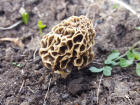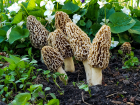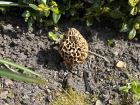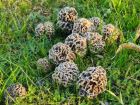Cap pale brownish cream, yellow to tan or pale brown to greyish brown. The edges of the ridges are usually lighter than the pits, and somewhat oval in outline, sometimes bluntly cone-shaped with a rounded top or more elongate. The caps are hollow, attached to the stem at the lower edge. The flesh is white, brittle, thin and hollow. Stem white to pallid or pale yellow, hollow, and straight or with a club-shaped or bulbous base. It is finely granular overall, and somewhat ridged. Spore print creamy white or pale ochre.
Microscopic Features: Spores are ellipsoidal, smooth, measuring 17.5-22 x 9-11µm, and hyaline.
Similar species include other Morchella species like Morchella elata (Black Morel). Gyromitra species can also be mistaken as Morchella esculenta but they lack the pitted cap and have a chambered, rather than a hollow, stem. One of these is Gyromitra esculenta (False Morel).
Note: Morchella esculenta and Morchella esculentoides are often considered as two different forms or varieties of the same species, commonly known as the common morel. Both forms have a similar appearance. However, there is some debate among mycologists about whether Morchella esculenta and Morchella esculentoides are distinct species or not. Some researchers suggest that the two forms may represent different ecological or genetic variants of the same species, while others argue that they should be treated as separate species.
Morchella esculenta on the www.first-nature.com web site.
Morchella esculentoides on the MushroomExpert.Com Web site.
The second photo is by DrewHeath and licensed under the Creative Commons Attribution 4.0 Unported license.
Many mushrooms are poisonous, and some can be lethally toxic. Distinguishing between edible and poisonous mushrooms can be very challenging. Therefore, we strongly advise against consuming wild mushrooms. This website does not contain any information about the edibility or toxicity of mushrooms.
Although efforts have been made to ensure accuracy on this website, the information may contain errors and omissions. Therefore, all content provided is for educational and informational purposes only and should not be relied upon or used as a basis for consuming any plants or mushrooms.
External links are provided for reference only. We do not endorse or take responsibility for the content, advice, or products found on these sites or in any advertisements shown on this website.




